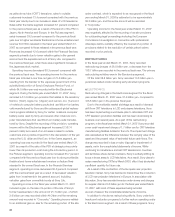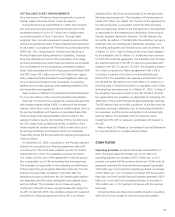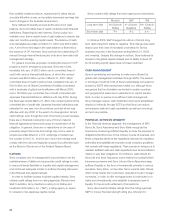Sony 2007 Annual Report Download - page 73
Download and view the complete annual report
Please find page 73 of the 2007 Sony annual report below. You can navigate through the pages in the report by either clicking on the pages listed below, or by using the keyword search tool below to find specific information within the annual report.70
where manufacturing takes place may be different from those
where such products are sold. In order to reduce the risk
caused by such fluctuations, Sony employs derivatives, including
foreign exchange forward contracts and foreign currency option
contracts, in accordance with a consistent risk management
strategy. Such derivatives are used primarily to mitigate the
effect of foreign currency exchange rate fluctuations on cash
flows generated by anticipated intercompany transactions and
intercompany accounts receivable and payable denominated in
foreign currencies.
Sony Global Treasury Services Plc (“SGTS”) in London
provides integrated treasury services for Sony Corporation and
its subsidiaries. Sony’s policy is that Sony Corporation and all
subsidiaries with foreign exchange exposures should enter into
commitments with SGTS for hedging their exposures. Sony
Corporation and most of its subsidiaries utilize SGTS for this
purpose. The concentration of foreign exchange exposures at
SGTS means that, in effect, SGTS hedges the net foreign
exchange exposure of Sony Corporation and its subsidiaries.
SGTS in turn enters into foreign exchange transactions with
creditworthy third-party financial institutions. Most of the
transactions are entered into against projected exposures before
the actual export and import transactions take place. In general,
SGTS hedges the projected exposures on average three months
before the actual transactions take place. However, in certain
cases SGTS partially hedges the projected exposures one
month before the actual transactions take place when business
requirements such as shorter production-sales cycles for certain
products arise. Sony enters into foreign exchange transactions
with financial institutions primarily for hedging purposes. Sony
does not use these derivative financial instruments for trading or
speculative purposes except for certain derivatives in the
Financial Services segment utilized for portfolio investments and
asset liability management (“ALM”).
To minimize the adverse effects of foreign exchange fluctua-
tions on its financial results, particularly in the Electronics
segment, Sony seeks, when appropriate, to localize material
and parts procurement, design, and manufacturing operations in
areas outside of Japan.
Changes in the fair value of derivatives designated as cash flow
hedges, including foreign exchange forward contracts and foreign
currency option contracts, are initially recorded in accumulated
other comprehensive income and reclassified into earnings when
the hedged transaction affects earnings. Foreign exchange
forward contracts, foreign currency option contracts and other
derivatives that do not qualify as hedges are marked-to-market
with changes in value recognized in Other Income and Expenses.
The notional amounts of foreign exchange forward contracts,
currency option contracts purchased and currency option
contracts written as of March 31, 2007 were 1,768.6 billion yen,
287.8 billion yen and 67.2 billion yen, respectively.
ASSETS, LIABILITIES AND STOCKHOLDERS’
EQUITY
ASSETS
Total assets on March 31, 2007 increased by 1,108.6 billion yen,
or 10.5 percent, to 11,716.4 billion yen, compared with the
previous fiscal year-end. Total assets on March 31, 2007 in all
segments excluding the Financial Services segment increased
by 711.3 billion yen, or 11.1 percent, to 7,098.1 billion yen and
total assets on March 31, 2007 in the Financial Services
segment increased by 409.5 billion yen, or 9.0 percent, to
4,977.6 billion yen, compared with the previous fiscal year-end.
■CURRENT ASSETS
Current assets on March 31, 2007 increased by 777.2 billion
yen, or 20.6 percent, to 4,546.7 billion yen compared with the
previous fiscal year-end. Current assets on March 31, 2007 in all
segments, excluding the Financial Services segment, increased
by 538.4 billion yen, or 18.2 percent, to 3,495.0 billion yen.
Cash and cash equivalents on March 31, 2007 in all seg-
ments, excluding the Financial Services segment, decreased
62.6 billion yen, or 10.7 percent, to 522.9 billion yen compared
with the previous fiscal year-end.
Notes and accounts receivable, trade (net of allowance for
doubtful accounts and sales returns) on March 31, 2007,
excluding the Financial Services segment, increased 369.5
billion yen, or 37.9 percent, compared with the previous fiscal
year-end to 1,343.1 billion yen. This was primarily the result of
an increase in sales of the PS3.
Inventories on March 31, 2007 increased by 136.2 billion yen,
or 16.9 percent, to 940.9 billion yen compared with the previous
fiscal year-end. This increase was primarily a result of both
increased semiconductor inventory, primarily for use in the PS3,
and LCD television inventory in the Electronics segment and
increased inventory in the Game segment resulting from the
























